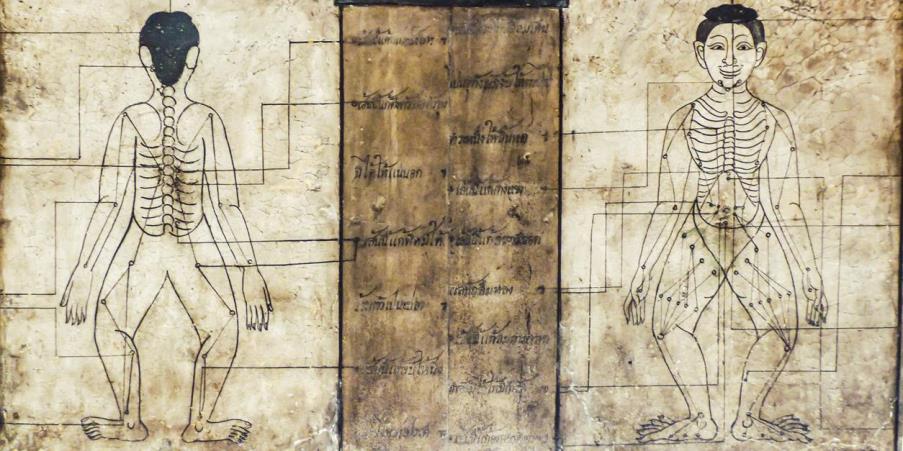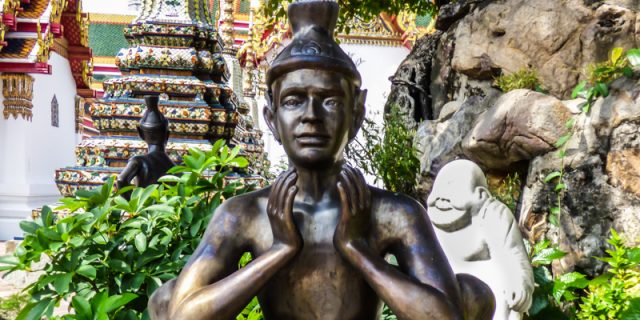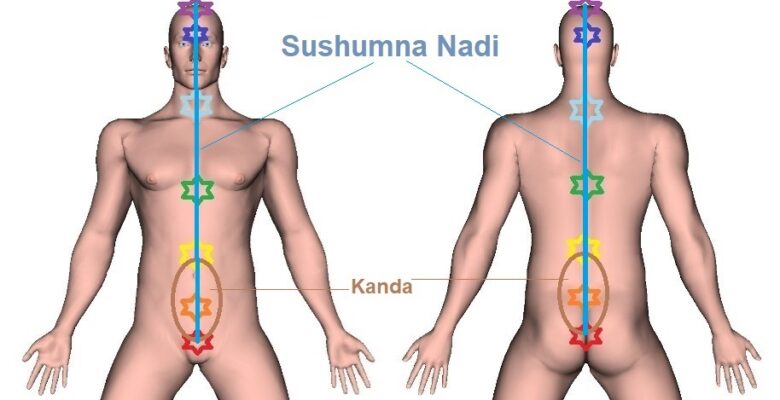
The origins and history of the Thai Sen Sib Energy Lines, officially called the Sen Prathan Sib, are shrouded in mystery. The ten primary energy channels are supposedly a subset of a total of 72,000 Energy Lines or Lom Pran Channels traversing through our bodies. Lom Pran, by the way, could be translated as Pranic Wind or Prana Life Energy.

Note that the Thai word prathan means “primary,” “main,” or “principal.” The word sen means “channel” or “pathway,” and sib means “ten.” As such, the phrase Sen Prathan Sib could be translated as “ten primary pathways.”
The legend tells us that Jivaka Kumar Bhaccha, the Father Doctor of Medicine in Thailand, personal physician of the Indian King Bimbisāra and the Buddha in the 5th century BCE, saw the 72,000 Energy Lines in deep meditation and distilled those to 10 major and most important life energy channels for reasons of simplifying the art of working with the Sen Lines.
True or not true, there are no textual or any other scriptural evidences i.e. Energy Lines charts or maps from Dr. Jivaka known that describe the Sen Lines. In any case, Jivaka being of Indian origin would have called them Prana Nadis (the Indian equivalent of the Thai Sen), yet those are mentioned in Indian literature already before the Buddha’s time. So, to be honest, to attribute Energy Lines knowledge only to Dr. Jivaka becomes somewhat doubtful.
In any case, when we look at the situation i.e. the earliest Sen Line evidence in Thailand, there’s no documentation about when and how the Sib Sen originated. Nevertheless, there are three important historical Thai records that today form the basis of the Sen Prathan Sib theory.
- The Tamla Loke Nitan Text (Tamra Rok Nithan Khamchan 11 i.e. Textbook of Etiology) from the reign of King Rama II (reign: 1809-1824 CE).
- The marble tablets inscriptions with graphics i.e. pictures at the Wat Pho temple (Wat Phra Chetuphon) in Bangkok, which were recorded during the reign of King Rama III (reign: 1824 – 1851 CE), also called the Pharb Phaen Nuad or Massage Illustrations. The first 18 stone plaques are about the ten primary Energy Lines.
- The Royal Traditional Thai Medicine Text (Section Massage Patterns or Phaen Nuad 1 and 2) written in 1870 during the reign of King Rama V (reign: 1868 – 1910 CE), called the Tamra Vechasart Chabab Luang.
Of course, the start of the reconstruction i.e. renovation of the old temple grounds of Wat Pho as from 1782, with the purpose that the temple would function as a repository of Thai medical knowledge, presupposes that knowledge of the Sen Lines already existed.

When we compare Sib Sen theory with the Yogic Prana Nadis we see that there are similarities, such as being considered paths of Life Energy (Prana or Lom Pran), the number of lines (72,000), and three first lines of the Sib Sen and the three principal Nadis having more or less the same names being Ida (Ittha), Pingala (Pingkhala), and Sushumna (Sumana), including parallels as for the trajectories they take through our bodies.
Nevertheless, there is no hard evidence of the other seven Sib Sen Lines having a direct relationship with the fourteen major Yoga Nadis, except for the fact that they are both considered pathways of Life Force Energy, have sometimes similar ending points (termination points), and sometimes mention similar functions.
Additionally, some acupressure points that lie on the Sen Lines have an equivalent in so-called Indian Marma or Varma points (connecting the gross and subtle pranic body) or in Chinese acupuncture points of which the latter also lie along the Chinese Meridians.
The fact that the Indian Nadis and the Chinese Meridians have a history of at least two millennia suggests that the Thai Sen Lines (the Thai having integrated Chinese, Indian, and their own medical knowledge) have a history much older than the Thai scriptural evidence of the 19th century CE let us believe.
Yet, it remains rather vague how much of Sen theory has been borrowed from the Indians or Chinese, and which part exactly is originally Thai Wisdom.

















